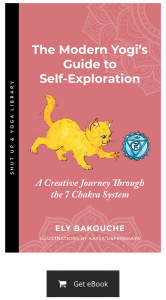Chapter 1: Introduction to Yoga Deconstructed®
In the Western world, yoga has become a household name and a $16-billion industry (Yoga Alliance 2016) that is viewed by many as a natural or non-medical remedy for stress, pain, and trauma. It is also seen as a low-impact and joint-friendly form of exercise that can improve flexibility and be used as an alternative to going to the gym. Between 2012 and 2016, the number of Americans practicing yoga doubled. The 2016 Yoga in America Study conducted by Yoga Journal and Yoga Alliance estimated that 36 million Americans practiced yoga, and found that flexibility and stress were the primary reasons people gave for taking it up (Yoga Journal 2016).
However, despite the fact that people seek out yoga for its gentle and therapeutic reputation, many yoga teachers and students are injured as a result of practicing it. An epidemiology study published in the Orthopedic Journal of Sports Medicine observed that between 2001 and 2014, there were 29,590 yoga-related injuries reported to hospital emergency departments. The trunk was the most frequently injured area, and sprains and strains accounted for 45 percent of the injuries. The greatest number of injuries occurred among people who were aged 65 and older (Swain and McGwin 2016). This is noteworthy because the number of people over the age of 50 practicing yoga tripled between 2012 and 2016 (Yoga Journal 2016).
Given that yoga is recommended as a gentle and joint-friendly form of movement, it is important for us to consider why so many people are injured or develop pain when practicing it. We should also ask ourselves what we can do as teachers to reduce the risk of this happening in our classes.
Why do people get hurt doing yoga?
Assessing how and why an injury happens is complicated; multiple factors must be considered, including the individual circumstances of the injured person. However, most yoga injuries can be linked back to a single cause: how Western yoga classes are typically taught and the outdated belief system within yoga culture that perpetuates this method of teaching.
Here is an overview of some common causes of yoga injuries. Subsequent chapters in this book will cover some of what is mentioned below in greater depth.
Many students have an idealized version of a pose that they want to achieve. However, they may not fully understand the exercise progressions required to prepare their body for that pose and may try to force the position, even if they experience discomfort or signals from their body that it is not the best position for them in that moment. As you read this book, start to consider how you can create a sense of curiosity and appreciation for progressive movement and incremental progress instead of valuing practicing the most difficult-looking pose.
Modern postural yoga classes are not well designed for individuals in the modern world
Modern daily life rarely demands diverse and dynamic movement. The average person wakes up and sits at their kitchen table to eat breakfast. From there, they might sit in their car to drive to work, where they sit at a desk for hours. When they return home, they relax by sitting on their couch to watch TV. Even if they go to the gym, they will only have been active for a small portion of their day.
Modern movement science has found that the human body adapts to the loads and positions to which it is most frequently exposed. As a result, the average person is well adapted to sit, stand, and walk short distances. It is also now thought that injuries occur when a joint is loaded in a range that it is not well adapted for and does not have the strength to control. This is applicable to asana, because the average class in the Western world is taught as a series of poses that require loading a large amount of one’s own bodyweight on to joints at their end ranges of motion. Given that the average person seldom, if ever, moves their joints to their end ranges of motion during daily life, it makes sense that doing so with little to no preparation when they begin a yoga practice might create the potential for injury. This could also explain why yoga injuries are so prevalent among older adults. The longer that an individual goes without loading their joints at the end ranges of motion, the weaker they will become in these ranges and the less prepared they will be to load their joints at the end ranges of motion during yoga practice. Beyond that, many people experience a steady decrease in strength as they age, so older adults could potentially have an increased risk of injury if they practice a movement for which they are not well prepared. A study published in the Muscle, Ligaments and Tendons Journal found that muscle strength declines between 16.6–40.9% for people between the ages of 40 and 80 (Keller and Engelhardt 2013). As a result, many of the individuals who come to our classes do not have the strength and movement skills required for the poses taught in a modern postural yoga class, which makes them vulnerable to injury. The solution to this is not to demonize traditional yoga poses, but to teach our students how to build strength through larger ranges of motion with a gradual increase in load over time. We can then better prepare them to practice yoga with a reduced risk of pain or injury.
Lack of cross training and external load
Pain or injury can also result from a lack of cross training and external loading when practicing yoga. Modern postural yoga is bodyweight training, which means the only option for loading is how much a person weighs. The majority of people who come to yoga are not strong enough to push their own bodyweight, and their joints are only prepared to tolerate the loads and directions of movement to which they have been regularly and progressively exposed. If someone loads their bodyweight on to a joint that is not well prepared to handle that load, it can result in injury.
This problem could be solved if modern postural yoga incorporated external loading, such as using dumbbells or resistance bands, allowing people to choose a level of resistance that their joints could safely tolerate. Over time, as their tissues became stronger and their joints adapted, people could choose heavier loads, until they were strong enough to train with their own bodyweight. In exercise science, this concept is known as progressive overload, which is defined as the gradual increase of stress placed upon a joint during exercise. Without the opportunity for progressive overload, most people’s muscles and joints are underloaded for the demands of a typical yoga class.
Another issue with the lack of external loading in modern postural yoga is that there are no opportunities to load in the direction of pulling. If someone also cross trains, this would not be a problem. However, asana is often the only form of physical exercise that yoga teachers and students practice. Over time, this can lead to an imbalance, where students become stronger in the pushing directions of movement and weaker in the pulling directions of movement. So, tissues are not only generally underloaded to meet the physical demands of yoga, they are more underloaded in the direction of pulling, which can compound the risk of pain and injury.
Pain and injury can result from underloading or overloading a joint. One of the issues with only practicing yoga is that it can create a scenario for the joints to become underloaded and overloaded at the same time. This is because most yoga classes involve a high repetition of a limited number of movements. For example, many forms of modern postural yoga practice set sequences of poses without deviation, meaning that a single class could involve performing the same poses dozens of times. When these poses are practiced repetitively, it can result in a repetitive stress injury, where pain is experienced in the muscles, nerves, and tendons as a result of overuse through repetitive movement. The ideal solution to reduce incidences of pain and injury from under- and overloading would be for yoga practitioners to include cross training using external resistance, such as strength training or Pilates exercises on the apparatuses. However, many students are resistant to going to the gym or performing exercise on their own. Instead, we can incorporate external load and pulling movements into our yoga classes to mitigate the negative effects of over- and underloading.
A check/recheck is any technique that can be used to self-assess changes in your body when practicing a sequence. Check/rechecks can apply to any type of sequence, including yoga poses, sensory feedback methods, somatic exercises, and preparatory exercises. Changes that you can assess for include range of motion, breath capacity, strength, emotional state, and positional awareness.
Exploration of external load and pulling movements
1. Triangle Pose with resistance band from underneath bottom foot to top hand
Check: Come into Triangle Pose. Step your feet about three- to four-feet apart. Turn your right foot out and your left foot in. Reach your arms out to the side horizontally at shoulder height. Move into deeper flexion at the right hip as you reach your right hand down and place it on your shin or a yoga block. Reach your left arm straight up to the ceiling. Notice how it feels.

Triangle Pose with a resistance band: Repeat the actions in regular Triangle Pose above, but use a resistance band by placing it underneath your right foot and holding it in your left hand. Or tie loops at either end of the band and put it around your right foot and left hand.
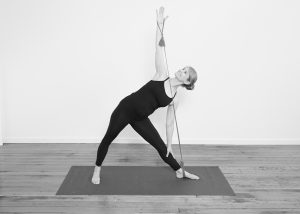
Recheck: Come into Triangle Pose. Notice how it may feel different after using the resistance bands. Did it feel easier to maintain muscular activation in the pose? Were there aspects of the pose that you couldn’t sense before that you can sense now, and if so, what were they? Do you still feel like you need to place weight into your bottom hand to sustain the pose?
2. Blanket on back of head and upper thoracic spine in plank
Check: Come into Plank Pose and sense the position of your rib cage, spine, and head. Can you sense where your head is relative to your spine? Can you sense where your shoulder blades are relative to your spine and rib cage without looking in a mirror?

Resume Plank Pose with a folded blanket resting on the back of your head and upper back. Notice if the feedback from the weight of the blanket helps you sense the position of your head and thorax.
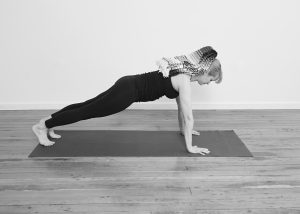
Recheck: Come into Plank Pose one more time without the blanket. Notice if it is easier to sense where your head, spine, rib cage, and shoulder blades are relative to one another. Often it is easy to sink in the rib cage or drop the head in Plank Pose. Notice if having the blanket as proprioceptive feedback and external resistance made it easier to find the muscular activation required to hold this pose.
3. Dandasana stretchy band rows
Check: Come into Plank Pose and slowly lower yourself onto your belly. As you bend your elbows, think about pulling yourself towards the floor and retracting your shoulder blades.

Dandasana with mid rows: Come into Dandasana with a resistance band looped around the bottom of your feet, one loop in each hand. Check that when your arms are straight you still have tension in the band. Slowly bend your elbows and pull the band towards you, while squeezing your shoulder blades together to activate the muscles in your upper and mid back.
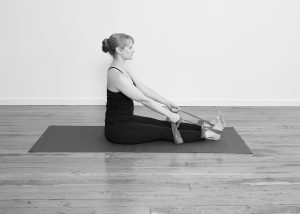

Recheck: Resume Plank Pose and slowly lower yourself onto your belly. Is it easier to come down in one piece rather than collapsing in one area of your torso, such as the pelvis, rib cage, or spine, after integrating your pulling muscles into the exercise?
Often after class, students ask questions about how to address overuse injuries or discomfort as a result of their yoga practice. In this scenario, it can be helpful to have a response prepared. If you are asked this question, how might you respond? For example, you could explain to them how cross training may be beneficial for their yoga practice. What other things might you say?
Competitive culture
The marketing and beliefs around yoga in the Western world are confusing and at times conflicting. On one hand, it is viewed as a gentle and therapeutic mind–body practice, which medical professionals recommend to their patients to reduce stress and alleviate pain. At the same time, it is represented on the covers of magazines and by social media influencers as a practice that allows the performance of impressive feats of flexibility and strength in the form of backbends, arm balances, and handstands, preferably on a beach with the perfect tan. These images are often accompanied by testaments to how yoga can help reduce anxiety, free us from self-judgment, achieve optimal health, and become our best selves. Becoming a more evolved person while mastering impossible-looking poses is a compelling sales pitch, especially in a society that rewards a perceived mastery of one’s body and mind. No wonder yoga has become so popular.
Beyond that, many people who seek out yoga to reduce stress are high achievers with a competitive streak who operate with the mindset that more is better. As a result, they are likely to choose classes that emphasize the performative aspects of the practice. Even if a person doesn’t have a desire to master advanced poses, they have likely heard the conventional wisdom that if something hurts, you should stretch it, and that increasing flexibility will help eliminate tension and pain. Since yoga is associated with increasing flexibility, it is an obvious choice for someone who is looking for a natural solution to addressing pain or discomfort.
When combined, these factors create a scenario where students have a preconceived notion of what their experience in a yoga class should entail before they ever step inside a studio. Since they’ve seen the poses in the media and heard about why yoga is good for you, they have predetermined expectations about what they should be learning in a class, a belief system around the right way to practice a pose, and often a specific goal in mind, which for the majority of people is to increase flexibility to minimize pain and tension, achieve difficult-looking poses, and reduce stress, preferably all at the same time.
There’s nothing inherently wrong with the desire to master acrobatic poses or become more flexible. However, students are often compelled to attempt the most advanced version of a pose and stretch to their furthest limits, instead of adjusting their movements based on how it feels. This can also create a need to chase a sensation by going as deep as possible into a pose. While this can cause issues for people with any level of flexibility, it can be particularly problematic for hypermobile students who won’t feel anything until they have moved into extreme ranges of motion, which can feel good in the moment but may contribute to joint instability and pain in the future. Furthermore, many students have been taught that pain is a normal part of the process and that if they practice long enough the pain will go away. This causes them to push through any warning signs that they may experience until the discomfort has escalated into an injury or a level of pain that can no longer be ignored.
This dynamic can be particularly challenging for yoga teachers. While they seek to build a sustainable practice using their understanding of how to prepare the joints for challenging poses in a way that minimizes the risk of pain and injury, their students might demand a certain type of pose or pacing based on their expectation of what yoga is supposed to look like. One of my hopes in writing this book is to give you a framework for teaching that is educational and empowering, and provides your students with an element of what they expect while minimizing their risk of pain and injury.
Hands-on assists
Many yoga teacher trainings include hands-on assists for yoga poses. While touch can be therapeutic in the right setting, it can be problematic in the yoga space. One issue is how hands-on assists are performed. Many hands-on assists in yoga involve pushing the body into extreme ranges of motion with force. For some students, any amount of force can feel like too much, for others, heavy amounts of force might feel good in the moment but could result in pain and even injury later.
Also, in a group class setting, teachers usually do not know the physical or mental health histories of their students. Without this history and the time to work with each student privately, teachers cannot know if a student has physical issues where adjustments are contraindicated. Furthermore, many individuals do not feel comfortable disclosing their mental health history to take a yoga class, and they shouldn’t be required to. For some individuals, any unexpected or unsolicited touch can be traumatizing, particularly if an individual has a history of trauma. For individuals with trauma, they may consent to touch, even if they don’t actually want it, and they may experience an adverse reaction to being touched. A research article published in Depression and Anxiety in 2019 looked at two studies that analyzed the experience and neural processing of interpersonal and impersonal touch with people who had been diagnosed with post-traumatic stress disorder (PTSD) as compared to people without a history of trauma. The studies concluded that while people without a history of trauma appreciated touch, individuals with a history of PTSD disliked it. This was also reflected in neural activation. The study found that for individuals with PTSD, hippocampal suppression occurred as an attempt to control traumatic memories that were evoked by touch and that this mechanism may maintain the aversion of interpersonal touch in patients with interpersonal trauma-related PTSD (Strauss et al. 2019). Even if they do not have a history of trauma, many students who attend a yoga class expect it to be similar to a group fitness class, where the teacher stands at the front of the room and instructs the class. In this situation, they will not attend class expecting to be adjusted, and may find being touched uncomfortable and an invasion of their personal space.
Beyond that, for many yoga teachers, hands-on assists go beyond their scope of practice. This is particularly relevant in the United States, where many states have laws that require a license to touch a client and specific education to legally be able to perform any type of adjustment involving stretching or moving another person’s body. Some professions with a license to touch include physical therapy, medicine, chiropractic, and massage therapy. In a broad sense, if you perform hands-on adjustments without the appropriate license and education, the laws of your state might interpret that action as practicing medicine without a license. With all of this in mind, a simple way to stay within your scope of practice and reduce the risk of injury in a group yoga class is to avoid hands-on assists when you are teaching.
A way to provide proprioceptive feedback to the body in a class setting without a hands-on assist is to use a prop.
Examples of how to use props in place of hands-on assists
1. Using a yoga block to provide tactile feedback in Plank Pose
If you are teaching Plank Pose, you can invite your students to place a yoga block horizontally across their shoulder blades and have them protract and retract their shoulder blades in this position. The weight of the yoga block will allow them to sense when they move into protraction that their spine comes into greater contact with the block, and when they move into retraction, their spine moves away from the block. In this scenario, the block replaces a hands-on assist that you might apply to the upper back between the shoulder blades to help your students notice what it is like to activate the muscles of their upper back to help support their joints in Plank Pose.

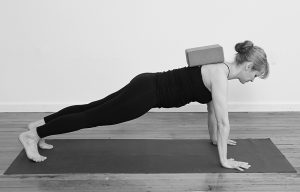
2. Using a yoga strap under the mid back when in supine to provide feedback to the positioning of the ribs
A common tendency during supine core exercises, such as dead bug, is to bring the mid back into spinal extension by lifting the base of the rib cage off the floor, which makes it difficult to sense the activation of the abdominal muscles. Since many students will be unaware that they are extending through the mid or lower back, it is beneficial to offer tactile feedback. In a private session, you could place your fingertips underneath the part of your student’s spine that is moving into extension. However, you could achieve a similar result in a class setting by first inviting students to find a partner. From there, one person would lie supine with a yoga strap on the floor positioned horizontally just below the inferior angle of the shoulder blades. You could then ask them to press that area of their back into the strap, so their partner is unable to pull the strap away. To minimize strain or hyperextension in the cervical spine, you may also need to place a blanket underneath the head and upper back.
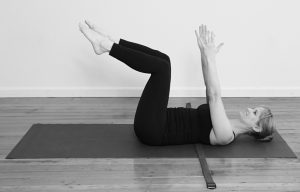
3. Using a block behind the pelvis to provide tactile feedback to pelvic positioning during side-lying movements
A common compensation in side-lying bent-knee hip circles is for the pelvis to roll backwards, which bypasses using hip muscles to create controlled circumduction at the hip joint. A hands-on strategy to address this might be to stand behind your student with your shin bone against their sacrum, so they can feel if their hip rolls back. A way to mimic this assist would be to invite them to place a yoga block behind their buttocks and instruct them to practice the movement without knocking the block over.

Consider your own thoughts and experiences with hands-on assists. Do you like or dislike them? Have you found them to be harmful or helpful? Do you believe that they are appropriate in a private session, but not in a group class? Do you find them beneficial in a teacher training, but not in a class for the general public? Use this reflection to begin to develop your own policy around how you will approach hands-on assists when teaching, and your own preferences when taking class in your personal practice.
Biomechanically incorrect cueing
Most yoga teacher trainings teach stylistic technique from a specific lineage, which means that the cues are usually not based on exercise science. As a result, many of the cues used in modern postural yoga contradict biomechanical principles about how joints are meant to move.
For example, a common yoga cue used for poses such as Warrior I and Downward Facing Dog is “pull your shoulders down.” This will cause many people to aggressively depress their shoulder blades, instead of allowing for the natural scapulohumeral rhythm of upward rotation. While depressing the shoulder blades in overhead movements won’t necessarily cause an injury, if practiced repeatedly it can create ongoing discomfort or irritation in the joint.
This is a single example of how an innocent cue can result in pain or an injury. However, there are numerous instances where this can happen at each of the joints. While yoga teachers don’t need to have an advanced degree in exercise science to teach safe classes, it is beneficial to learn more about how joints are meant to move, so we can understand if the cues that we are using make biomechanical sense.
Exploration of upward rotation versus scapular depression with full shoulder flexion
Find a comfortable seated position and slowly reach your arms out in front of you and up to the ceiling. Pause when your upper arm bones are next to your ears. Can you sense the upward rotation of your shoulder blades in this position?

Repeat the same action. However, once your upper arm bones are next to your ears, depress your shoulder blades down towards the floor.

Can you sense how these two ways of moving into glenohumeral flexion involve different types of muscular engagement and placement of the scapulae?
Consider why you choose the cues that you use when teaching yoga. Do you use certain cues because you are repeating what you heard your teacher say in your yoga teaching training, or do you choose cues with the goal of helping a student learn a movement skill or better understand a movement that they are practicing? If you do have a favorite way to cue certain poses, do these cues seem to elicit more clarity or confusion for your students when you watch them move?
What is Yoga Deconstructed?
Yoga Deconstructed is an approach to teaching yoga that incorporates modern movement science in helping to prepare students for asana and activities of daily life. This teaching approach addresses some of the more common reasons why someone might experience pain or injury when practicing yoga. Yoga Deconstructed incorporates regressions, progressions, somatic movements, sensory feedback methods, and preparatory exercises to prepare the joints for asana and introduces external loads and pulling movements to reduce the risk of repetitive stress injuries. It also structures the class in a way that honors the experience of yoga, while teaching functional movement skills that make the practice more accessible and sustainable for students.
There is no rule that a yoga class must include functional movement skills. However, it is important to consider the benefits of unspecialized or functional movement and how these benefits relate to the motivation behind why many of our students come to yoga. While some students may want to learn how to do challenging arm balances or the splits, many people decide to try yoga because a medical professional recommended it to reduce stress or pain. Additionally, for many people, yoga is their only form of exercise, so a yoga class might be the one opportunity that they have to improve their movement fluency and resiliency. If a student is attending a yoga class with the primary goal of mastering challenging yoga poses, this approach can help them prepare for advanced poses, while reducing their risk of injury. Ultimately, incorporating these ideas into your teaching can better meet the needs of all your students regardless of their goals.
Yoga Deconstructed is different from most modern postural yoga classes both in the sequence and selection of the poses. Unlike a traditional vinyasa flow class, this approach incorporates external load through the use of props and a series of pose progressions and regressions to prepare the body for a sequence of peak poses. The result is a class designed around exercise science principles that promotes strength and resilience and builds the foundation for a lifelong yoga practice.

Trina Altman, B.A., E-RYT 500, YACEP, NCPT, STOTT PILATES® certified instructor, is the creator of Yoga Deconstructed® and Pilates Deconstructed®, which shows movement teachers and clinicians how to modernize their teaching and create a more sustainable practice through an interdisciplinary approach based on current movement science.






